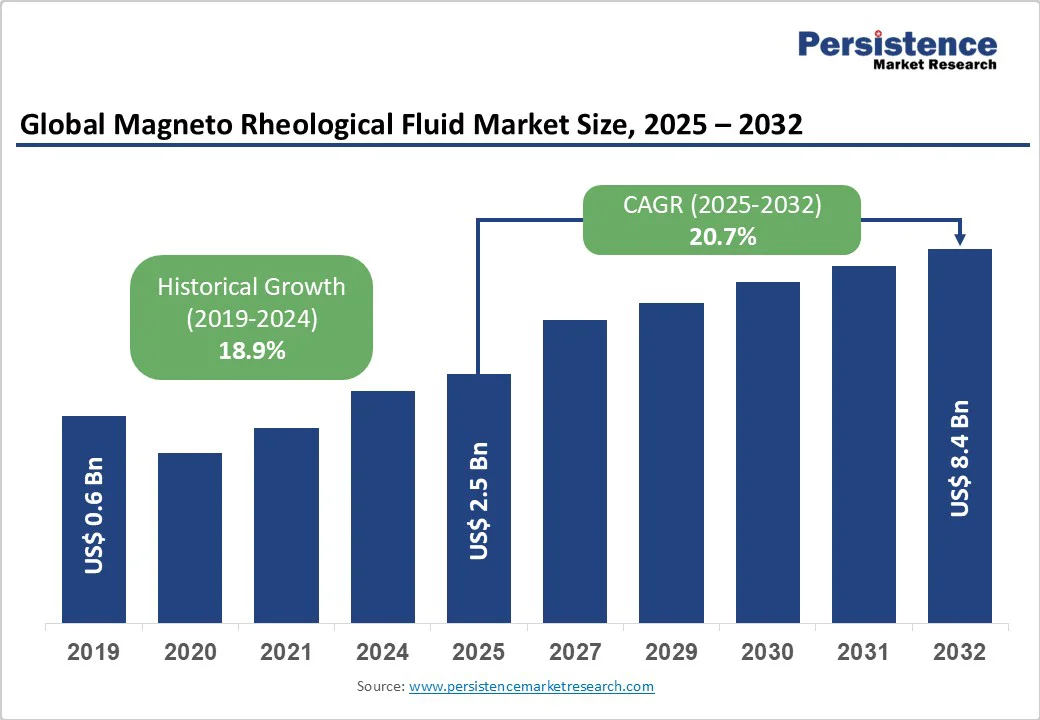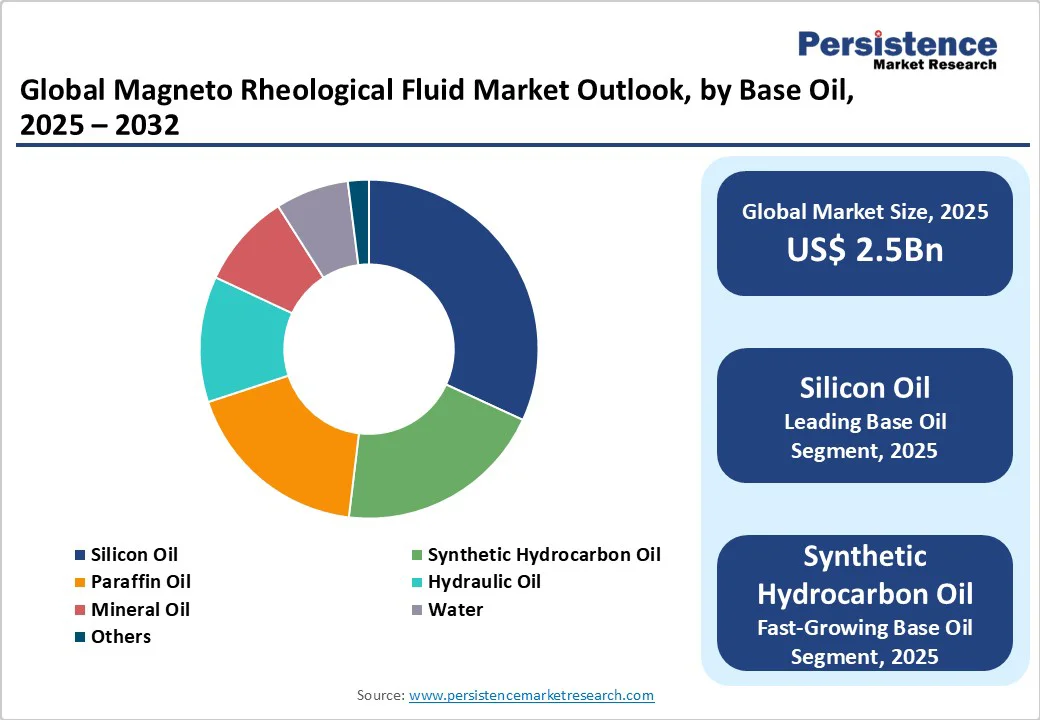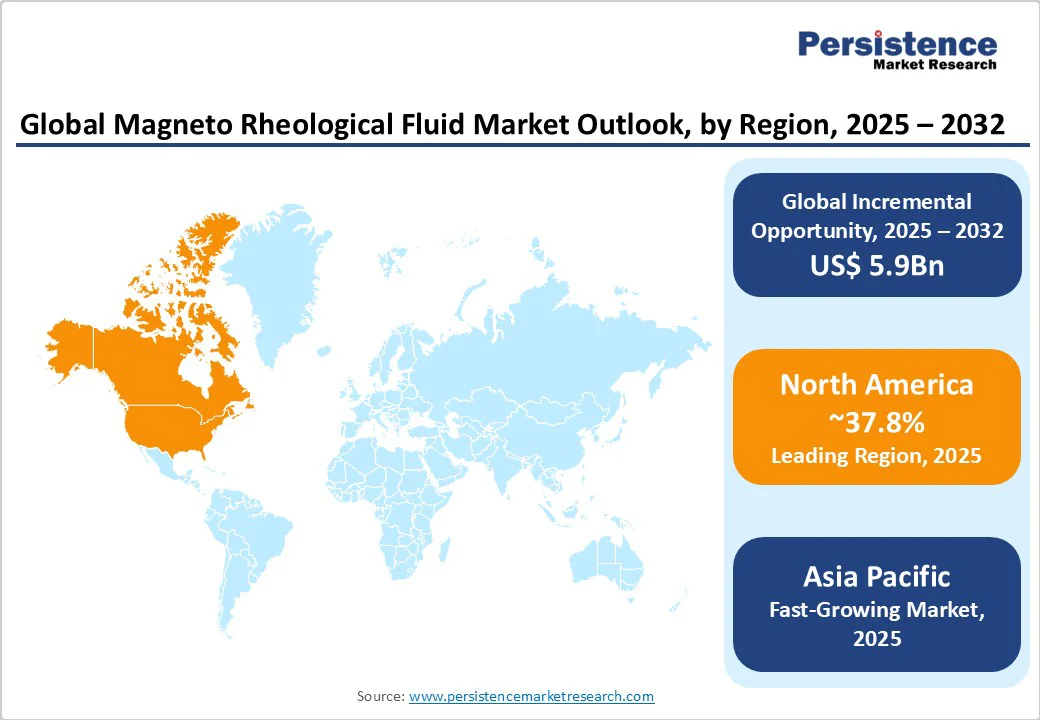ID: PMRREP34415| 184 Pages | 29 Sep 2025 | Format: PDF, Excel, PPT* | Chemicals and Materials

The global magneto rheological fluid market size is likely to be valued at US$2.5 Bn in 2025 and reach US$8.4 Bn by 2032, growing at a CAGR of 20.7% during the forecast period from 2025 to 2032. The magneto rheological fluid market is witnessing robust growth, driven by increasing demand from key industries such as automotive, aerospace, and military and defense, where adaptive damping and precise control are critical.
| Key Insights | Details |
|---|---|
|
Magneto Rheological Fluid Market Size (2025E) |
US$ 2.5Bn |
|
Market Value Forecast (2032F) |
US$ 8.4Bn |
|
Projected Growth (CAGR 2025 to 2032) |
20.7% |
|
Historical Market Growth (CAGR 2019 to 2024) |
18.9% |

The global magneto-rheological fluid market is experiencing significant growth due to the surge in infrastructure and construction activities worldwide. Magneto-rheological fluids are critical in construction for adaptive damping in seismic isolators, vibration control in high-rise buildings, and smart structural systems that enhance safety and longevity. According to the Global Infrastructure Hub (GI Hub), global infrastructure investment needs are expected to reach $94 trillion by 2040, with a significant portion allocated to emerging economies focused on resilient urban development.
In the Asia Pacific, China's Belt and Road Initiative and India's Smart Cities Mission drive demand for magneto rheological fluids in earthquake-resistant structures and bridge dampers. The American Society of Civil Engineers reports that over 46,000 U.S. bridges are structurally deficient and require repair or replacement, further increasing the need for advanced damping solutions. Companies such as Lord Corporation reported sales increases in construction-grade magneto rheological fluids in 2024.
Government-led initiatives and rising urbanization are expected to ensure sustained demand, positioning construction as a key driver of magneto rheological fluid market growth through 2032. This driver not only amplifies market size but also underscores the fluid's role in sustainable building practices, where real-time adaptability reduces maintenance costs by up to 30%, as per industry benchmarks from the International Association for Bridge and Structural Engineering.
The magneto-rheological fluid market faces challenges due to fluctuating raw material prices and growing competition from alternative smart fluids. Production relies heavily on magnetic particles, such as carbonyl iron and carrier oils, both of which are subject to price volatility influenced by global supply chains. This volatility increases pricing pressures, particularly for smaller players, limiting their ability to compete in cost-sensitive markets.
In addition, alternative smart fluids, such as electrorheological fluids, are gaining traction due to their electrical responsiveness and lower magnetic dependency, offering similar viscosity control in niche applications. Limited standardization in some regions and concerns over sedimentation in long-term storage further hinder adoption, particularly in medical and prosthetic applications, where precision is paramount, restraining overall magneto-rheological fluid market growth.
The increasing focus on renewable energy and electric vehicles (EVs) presents significant opportunities for the magneto-rheological fluid market. Magneto rheological fluids are essential in renewable energy projects, such as wind turbine blade pitch control and vibration damping in solar trackers, for precise load management. The International Energy Agency projects global renewable energy capacity to grow by 2.7 times by 2030, with wind and solar investments driving demand for adaptive fluids that enhance efficiency.
In the EV sector, magneto-rheological fluids are utilized in active suspension systems and regenerative braking components, enhancing handling and improving energy recovery. Companies such as Lord Corporation are innovating with low-viscosity formulations for EV dampers, aligning with sustainability trends. Government incentives, such as the EU’s Green Deal, aim for a 55% emissions reduction by 2030, further encouraging investments in green technologies, creating opportunities for manufacturers to develop advanced, eco-friendly magneto rheological fluids to meet evolving industry needs through 2032.

The Asia Pacific region stands out as the fastest-growing market, propelled by rapid industrialization and booming automotive and electronics sectors, particularly in China and India. The China Association of Automobile Manufacturers (CAAM) projects that China’s vehicle production will grow by approximately 3% in 2024, potentially reaching 31 million units. This growth, driven largely by the expanding electric vehicle (EV) segment, fuels rising demand for advanced suspension fluids critical to EV performance and durability. Government subsidies and supportive policies under China’s 14th Five-Year Plan further accelerate innovation and adoption of cleaner automotive technologies.
India’s robotics sector is gaining momentum, enhancing automation through adaptive grippers that improve precision and efficiency in manufacturing. Domestic companies such as Industrial Metal Powders Pvt. Ltd. are expanding production capacity to meet increasing demand, supporting India’s drive toward advanced manufacturing and smart automation. Together, these developments underscore Asia Pacific’s pivotal role in shaping the future of automotive and robotics industries, fostering innovation and sustainable growth across the region.
North America dominates the magneto rheological fluid market, accounting for 37.8% in 2025, driven by robust demand from the aerospace and defense sectors in the U.S. and Canada, supported by advanced R&D infrastructure. The U.S. aerospace and defense (A&D) industry generated over $995 billion in total business activity in 2024, with $443 billion in economic value, accounting for approximately 1.5% of the U.S. GDP, relies heavily on magneto rheological fluids for F-35 fighter jet dampers and Boeing 787 stabilizers. Canada's defense spending, up 15% to $30 billion in 2024 per DND, fuels military applications such as adaptive exoskeletons.
Major players such as Lord Corporation and QED Technologies International, Inc. dominate with U.S.-based innovation hubs, catering to projects in unmanned aerial systems. Consumer preference for high-tech, reliable fluids strengthens North America’s position, with drivers including FAA certifications and a surge in space tech funding.
Europe is the second fastest-growing region for the magnetorheological fluid market, propelled by strict safety regulations and rising demand across automotive, medical, and infrastructure sectors. Countries such as Germany and France are actively upgrading infrastructure, increasing the need for adaptive fluids that enhance performance and safety. In the automotive sector, leading brands such as Mercedes-Benz utilize magnetorheological fluids in advanced suspension systems to improve ride quality and meet stringent EU emissions and safety targets.
Meanwhile, Germany’s growing medical prosthetics market drives innovation focused on biocompatibility and precision, boosting demand for specialized adaptive fluids. The European Union’s Green Deal further supports growth by allocating €1 trillion towards renewable energy and sustainable technologies, including wind turbine controls where adaptive fluids play a key role. Companies such as Kolektor Group are at the forefront of innovation, developing solutions that ensure regulatory compliance and sustainability. Together, these factors position Europe as a critical hub for advanced fluid technologies aligned with quality, safety, and environmental priorities.

The global magneto-rheological fluid market is highly competitive, characterized by extensive product portfolios and global distribution networks. It is characterized as a fragmented market based on competitors. This is due to the presence of numerous domestic and international players, ranging from large, established companies to smaller, regional manufacturers. Regional players such as Industrial Metal Powders Pvt. Ltd. focus on localized offerings in the Asia Pacific. Companies are investing in advanced nanoparticle technologies and eco-friendly formulations to enhance market share, driven by demand for high-performance fluids in the automotive and aerospace sectors.
The Magneto Rheological Fluid market is projected to reach US$2.5 Bn in 2025.
Growing infrastructure and construction activities, and expanding applications in renewable energy are the key market drivers.
The Magneto Rheological Fluid market is poised to witness a CAGR of 20.7% from 2025 to 2032.
The rising demand in the renewable energy and electric vehicle sectors is the key market opportunity.
Lord Corporation, Arus MR Tech, QED Technologies International, Inc., and Liquids Research Limited are key market players.
| Report Attribute | Details |
|---|---|
|
Historical Data/Actuals |
2019 - 2024 |
|
Forecast Period |
2025 - 2032 |
|
Market Analysis |
Value: US$ Bn/Mn, Volume: As Applicable |
|
Geographical Coverage |
|
|
Segmental Coverage |
|
|
Competitive Analysis |
|
|
Report Highlights |
|
By Base Oil Insights
By Product Type
By Application
By Region
Delivery Timelines
For more information on this report and its delivery timelines please get in touch with our sales team.
About Author